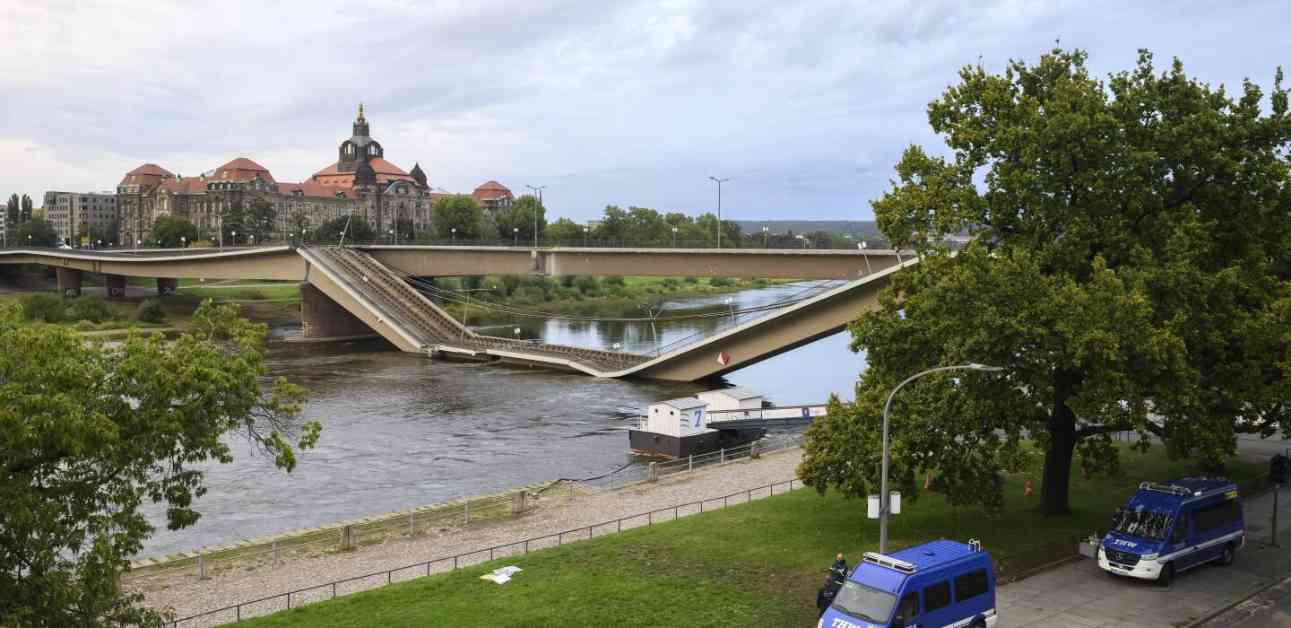Germany’s transportation infrastructure is facing a significant challenge as the collapse of a bridge in Dresden on Wednesday highlighted the urgent need for renovation across the country. This incident serves as a stark reminder of the deteriorating state of thousands of bridges in Germany, posing a pressing issue that will strain the nation’s public finances.
View of the partially collapsed Carola bridge over the Elbe in front of the State Chancellery in Dresden, Germany, on Thursday, September 12, 2024. – Robert Michael/AP/SIPA
The Situation
One of Dresden’s key bridges in the eastern part of the country collapsed early Wednesday morning. Local authorities attribute the incident to the corrosion of steel parts. Municipalities are urging the government to allocate more funds to prevent similar disasters. In Dresden, the military has been mobilized to clear the debris to avoid exacerbating the expected floods in the coming days.
Around 3 a.m. on Wednesday, a section of the Carola bridge in central Dresden collapsed over a hundred meters. The tram lane ended up in the Elbe River, fortunately without causing any casualties. The damage to this infrastructure, completed in 1971, appears to be due to steel corrosion, according to local authorities. The bridge had been considered in poor condition for a long time, but the Saxony capital municipality had refrained from restricting traffic on this axis, one of the four crossing the river in the city center.
Challenges Ahead
The collapse of the Dresden bridge underscores the challenges that Germany faces in maintaining its aging transportation infrastructure. With thousands of bridges in need of renovation and repair, the financial burden on the German government is set to increase significantly. The incident serves as a wake-up call for the authorities to prioritize infrastructure investments to ensure the safety and efficiency of the country’s transportation networks.
In response to the bridge collapse, calls are growing for stricter infrastructure inspections and maintenance protocols to prevent similar disasters in the future. The incident has also sparked debates about the allocation of resources and funding for infrastructure projects across Germany. As the country grapples with an aging transportation network, the need for proactive measures to address structural deficiencies becomes more urgent than ever.
Government Response
Following the collapse of the Carola bridge, the German government is under pressure to take swift action to address the state of the nation’s infrastructure. Calls for increased funding for bridge maintenance and renovation projects have intensified, with local authorities urging federal intervention to prevent further infrastructure failures. The government’s response to this crisis will be crucial in determining the future resilience of Germany’s transportation systems.
In light of the Dresden bridge collapse, the German government has announced plans to allocate additional resources to accelerate the renovation of critical infrastructure across the country. The incident has underscored the importance of prioritizing infrastructure investments to ensure the safety and reliability of transportation networks. As Germany grapples with the challenges of an aging infrastructure, decisive government action is essential to address the nation’s growing transportation needs.
In conclusion, the collapse of the Carola bridge in Dresden serves as a stark reminder of the urgent need to address the deteriorating state of Germany’s transportation infrastructure. With thousands of bridges in need of renovation and repair, the nation faces a significant challenge in maintaining its critical transportation networks. The government’s response to this crisis will be crucial in ensuring the safety and efficiency of Germany’s infrastructure for years to come.

